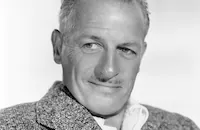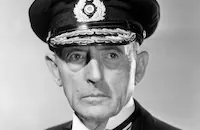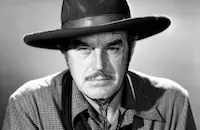Remember Last Night?
Brief Synopsis
Cast & Crew
James Whale
Edward Arnold
Robert Young
Constance Cummings
George Meeker
Sally Eilers
Film Details
Technical Specs

Synopsis
After six months of wedded bliss, Tony Milburn and his wife Carlotta celebrate their "anniversary" with a traveling "Jubilee Binge," which begins with liquid hors d'oevres at the mansion of their friends, Vic and Bette Huling. During the evening Vic finds Bette in the garden speaking with their mechanic, Fred Flannagan, and, long suspecting an affair between the two, Vic fires Fred. He later threatens his friend, Billy Arliss, because Billy is unable to repay a large debt. When Tony upbraids Vic for picking on Billy, Vic tries to hit him, but Jake Whitridge intervenes. The party continues on to its next destination, Billy's palatial home, where the revelers don blackface masks and drink champagne with straws from a soup tureen. The next stop is at Jake and his wife Penny's home, and from there the drunken rabble go to Faronea's restaurant. Unknown to them, Faronea has arranged with Vic's French chauffeur, Baptiste Bouclier, to kidnap Vic that evening and hold him for ransom. The next morning, Tony and Carlotta awaken with hangovers in a lavish bedroom in the Huling home. Neither can remember their activities the previous night, and both are mortified to discover Vic dead in his bed, shot through the heart from under his arm. Bette is not at home so Tony calls his friend, district attorney Danny Harrison. While Danny's assistant, Maxie, interviews the French maid, Florabelle, Danny begins his investigation. Bette arrives with Billy, at whose home she awoke. Bette later discovers cancelled checks in her safe for over $100,000, signed by a stranger whom no one knows. Because circumstantial evidence points to Tony as the murderer because of his argument with Vic, he calls in hypnotist Professor Karl Herman Eckhardt Jones to hypnotize all the suspects. Jones emerges from his interviews and states that one person tried to fool him, but before he can reveal the name, he is shot dead. Carlotta finds a note to Bouclier telling him to go to Faronea's wine cellar. She and Tony go there and hide while Faronea discusses a deal with someone, but Faronea discovers the couple. Trying to scare him, Tony tells Faronea he is working with police and knows that Faronea intended to kidnap Vic, but Bouclier killed him instead and confessed. Faronea is killed by his accomplice, who escapes, but his death confirms Tony's story. Tony and Carlotta return to the Huling home, and while Carlotta is inside, Tony searches the chauffeur's quarters where he finds Bouclier murdered. Tony and Danny question Bouclier's mother, and learn that her son had paid for expensive operations that cured her blindness. In the armoire, they find a note to Bouclier thanking him for "bumping off" Jones. Later, Danny interrogates Fred who turns out to be Bette's brother, an ex-convict, but apparently is innocent of the recent criminal activities. Jake responds to a call from Billy, who is hysterical, but when Danny and Tony arrive moments later as planned, Jake knocks Billy over the head and hides his body. Billy recovers, however, and attempts to shoot Jake, but Tony saves him, and Billy collapses. After Bette, Penny and Carlotta arrive, Danny explains the whole mystery: Billy borrowed money for Jake from Vic using a pseudonym, but when Jake rewrote the check to read $150,000 instead of $50,000, Vic forced Billy to tell him for whom he borrowed the money. Jake shot Vic in his home, then took him to the pool during the party, but everyone was so drunk they thought he had merely passed out. Jake paid off Bouclier to remain quiet, which is why Bouclier shot Jones, then Jake shot Bouclier. Danny now arrests Jake, and Florabelle identifies him as Bouclier's murderer, because she was in Bouclier's room that night. Danny also has evidence tying Jake to Vic's attempted kidnapping. Danny asks Carlotta and Tony to swear off alcohol, so they drink a toast to that, and the Hulings' butler Phelps quits.

Director

James Whale
Cast

Edward Arnold

Robert Young

Constance Cummings

George Meeker

Sally Eilers

Reginald Denny
Louise Henry

Gregory Ratoff

Robert Armstrong

Monroe Owsley

Jack La Rue

Edward Brophy
Gustave Von Seyffertitz

Rafael Ottiano

Arthur Treacher
Alice Ardell

E. E. Clive

Frank Reicher
Monte Montague
Dewey Robinson
Joe North

Harry Woods
Charles Delamotte
Frank Terry
Corbett Morris
Kate Price
Alex Chivra
Warner Richmond
Wade Boteler

James Flavin

James Burke
William Pawley
Crew
Scott R. Beal
Harry Clork
Ernst Dryden
John P. Fulton
Charles D. Hall
Bill Howard
Ted Kent
Gilbert Kurland
Carl Laemmle Jr.
Carl Laemmle
Carl Laemmle
Doris Malloy
Harry Mancke
Dixie Martin
Helen Mccaffrey
Murray Roth
Harvey Shepard
Isabelle Sheridan
Dan Totheroh
Joseph Valentine
Franz Waxman
Vera West
James Whale

Film Details
Technical Specs

Articles
Remember Last Night?
Bride of Frankenstein is remembered as director James Whale's masterpiece today, and it was far from a cult movie in its own day; it was so well received, both critically and financially, that the structure of production at Universal Studios changed as a result. Producer Carl Laemmle, Jr. (son of the studio head) replaced production chief Stanley Bergerman and instituted a "unit system" at the studio. Copying what had been set up at Metro-Goldwyn-Mayer, this new system gave power to separate producers to turn out a slate of pictures during a given year. For his own slate for 1935, Laemmle included a big-budget project for James Whale, an adaptation of the well-loved Broadway musical Show Boat.
Unfortunately, there were to be delays in starting production of Whale's million-dollar musical. Irene Dunne was set to star, but she was already committed to another Universal project, John M. Stahl's Magnificent Obsession (1935). To fill in the time gap, "Junior" (as the younger Laemmle was known around the studio) pressured Whale to direct a sequel to the studio's first foray into horror, Dracula (1931). Whale, however, was anxious to break away from the horror genre that he defined in the early sound era. (Before his current hit, he had directed the original Frankenstein (1931), as well as The Old Dark House (1932) and The Invisible Man (1933)).
Whale cast about for another project that he would find more engaging than Dracula's Daughter. A friend suggested a newly published book, The Hangover Murders, a comedy-mystery in the style of Dashiell Hammett's The Thin Man. As James Curtis writes in his biography, James Whale: A New World of Gods and Monsters, "The story satisfied Whale's needs on several levels. As with Bride of Frankenstein, it called for stylistic fireworks. It would play almost exclusively on interior sets, meaning it could be shot quickly and inexpensively. Lastly, it would play primarily as a comedy - as had The Thin Man - and Whale had never brought off a comedy with complete success." Laemmle had Whale promise that he would still direct Dracula's Daughter, and agreed to purchase the rights to The Hangover Murders for $5,000.
From the start, there were problems with the material. When the Production Code Administration reviewed the script, they strongly warned that state and local censorship boards were bound to cut some of the scenes of drinking and resulting inebriation, and that the occasionally bawdy dialogue (Carlotta, upon hearing that the Marines have landed: "There'll be atrocities - I want to be first!") would be similarly threatened. The project's title proved problematic as well. Early on, Laemmle assured the Breen Office that he would eliminate the word "hangover," so for a time during production the film was to be called Wild Night. Following a survey of exhibitors, the title became Remember Last Night?
Laemmle gave Whale a budget of $385,000, and Robert Young was borrowed from MGM for the male lead role. Whale filmed the script pretty much as written, in effect ignoring the warnings of the Breen Office; revelers drank champagne from huge bowls with straws, pranced in blackface masks, jumped in cars while obviously drunk, freely broke glass objects both large and small, and even took potshots at passing ships with a cannon off the balcony of their Long Island mansion! Filming ended on September 14, 1935; Whale went nine days over schedule and $75,000 over budget. The finished film was shown to the PCA, and Breen still felt that the emphasis on drinking should be downplayed in cutting. Whale only made minor cuts for pacing, and the film went out basically as he intended, opening on November 4. Remember Last Night? fared poorly at the box office. Critical reaction was mixed; while many reviewers felt the film to be in bad taste, some appreciated the wild tone that Whale brought to the proceedings. The Hollywood Reporter was delighted, saying that Whale "let himself go in a riotous directorial splurge," resulting in "a murder mystery to kid all murder mysteries."
Whale followed up Remember Last Night? with his elaborate adaptation of Show Boat (1936), but he escaped directing Dracula's Daughter (1936) or any other horror film in his career. He got the last laugh in Remember Last Night?, in fact, as Curtis points out: "Whale inserted some lines mocking the horror pictures from which he was now trying to distance himself. During a flashback, he showed Carlotta bouncing boisterously on a diving board, flapping a beach towel and hollering, 'Look! I'm Dracula's Daughter!' Later, when she and Tony investigate a musty underground hideout, she grouses, 'I feel like the Bride of Frankenstein!'"
While it was mostly forgotten for decades, Remember Last Night? has seen a revival of interest in recent years, corresponding with the renewed attention paid to director Whale. In Time Out Film Guide Tom Milne called the film a "delightful screwball parody of the detective thriller," and said that "Whale's use of elisions, non-sequiturs and unexpected stresses creates what is virtually a blueprint for the style developed by Robert Altman in and after M*A*S*H (1970)."
Producer: Carl Laemmle, Jr.
Director: James Whale
Screenplay: Harry Clork, Louise Henry, Adam Hobhouse (novel), Doris Malloy, Dan Totheroh
Cinematography: Joseph Valentine
Film Editing: Ted Kent
Art Direction: Charles D. Hall
Music: Franz Waxman
Cast: Edward Arnold (Danny Harrison), Robert Young (Tony Milburn), Constance Cummings (Carlotta Milburn), Sally Eilers (Bette Huling), Reginald Denny (Jake Whitridge), Monroe Owsley (Billy Arliss), George Meeker (Vic Huling), Arthur Treacher (Clarence Phelps), Gustav von Seyffertitz (Prof. Karl Herman Eckhardt Jones).
BW-81m.
by John M. Miller

Remember Last Night?
Quotes
Trivia
Notes
The working title of the film was Hangover Murders. Although Sally Eilers was listed above the title in the credits, she was listed after George Meeker in the end credits. Contemporary sources indicate the film was a commercial failure. Robert Young was borrowed from M-G-M for this picture. According to modern sources, Benn W. Levy wrote additional dialogue, Mischa Bakaleinikoff was musical director, and Jack Pierce did make-up for the production. Modern sources note that Benn W. Levy was a friend of director James Whale and the husband of star Constance Cummings, and while present during some of the filming, contributed to the script.














